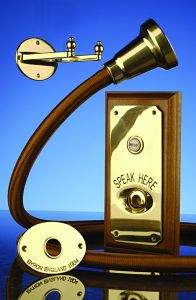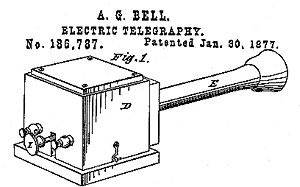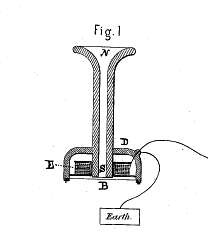|
The True History of the Speaking Tube |
||||
Albert Weatherspoon's single most important technological invention is clearly the speaking tube. Before you tell me that the speaking tube was invented a hundred years before, consider that the Rubovians are so out of touch that they totally failed to notice what was going on in the world outside of Rubovia and its immediate neighbours. Therefore, an electrical telephone, such as invented by Alexander Graham Bell, was inconceivable due to the fact that Rubovians had never heard of electricity. Completely out of touch with the rest of the world, Rubovian technological development stopped at gas and steam. They also love clockwork, spring-driven gramophones, and things operated with bellows, pulleys, and bits of string. The voice- and air-powered speaking tube fit perfectly into this (by modern standards) rather antiquated milieu. Rubovia was so much in its own little world, that even while not meeting the usual requirements for independent invention (synchronicity being one of them and no knowledge of other work being the other), I think it is fair to say that the speaking tube was independently invented in Rubovia, by its foremost inventor, Mr. Albert Weatherspoon, of Weatherspoon and Cat Limited. The need for such a communications technology was very clear. Countless demands placed on Mr. Weatherspoon by the Rubovian royals required so much waiting around, and/or running up and down castle stairs, that he had far too little time to catch his breath, let alone invent. Mr. Weatherspoon's speaking tube invention allowed him to continue to work on various projects, whether in his rooms, or in the castle basement, yet still be a mere whistle away. For all of its simplicity, the speaking tube served this purpose rather well, with an audio quality that surpasses most modern telephones. For these reasons, Mr. Weatherspoon has a great fondness for the speaking tube, as evidenced by his typical response to the call whistle, "Ooh, it's the speaking tube, puss". Interesting Speaking Tube Facts
Byron Bells Recreates A Classic Speaking Tube
C. H. Byron (www.chbyron.co.uk, tel.
01527-557-700),
an acknowledged innovator and leading producer of upscale doorbells
and pushes in Great Britain, makes a reproduction front door speaking tube.
Based on a 1904
design by founder Charles Hands, it is designed around a stylish
polished wood
block with lacquered brass plate, and sold brass components and fittings, it incorporates a
porcelain
electric bell push, and an engraving above the speaking
tube orifice, appropriately labelled, "SPEAK HERE". A
flexible, braided fabric-covered tube links the front door
speaking facility to the inside of the house where you can use it
to speak
to callers in comfort and security. Speaking Tube in Bell Telephone
Perhaps indicating a certain clinging to the past, A.G. Bell's 2nd telephone patent (No. 186,787, Electric Telegraphy/Telephony) shows a speaking tube (E in figure) connecting a flared mouthpiece and an electromagnetic telephone transducer element. The patent says that E represents a speaking tube, by which sounds may be conveyed to or from a diaphragm inside box D, not shown.
A similar speaking tube arrangement (N in figure) shows up in A.G. Bell's 3rd telephone patent (No. 201,488, Improvement in Speaking-Telephones). Due to improvements in the techniques used, notably the break-through invention of high-output carbon granule microphones, the speaking tube gain-device was no longer necessary, and was dispensed with (see, e.g., his 4th telephone patent, No. 213,090, dated March 11, 1879).
Rubovian Speaking Tube Memories Although not part of the original history of the speaking tube, Gordon Murray's use of speaking tube technology in A Rubovian Legend is part of its more recent history. Here is a selection of memories. Enjoy!--o000o-- The phrase I remember the most was Weatherspoon's, "Oh! It's the speaking tube, puss." It became something of a catch phrase for us, whenever the phone rang. The 'speaking tube' was used by the King and others to summon Weatherspoon from his workshop. I can't remember if it was always there or whether it was added at some point.
Weatherspoon: "Oo puss, it's the speaking tube." The speaking tube has still not been surpassed by so-called 'modern technology'. Where can I buy a speaking tube? Thought Weatherspoon's "Speaking Tube" was marvellous. [Weatherspoon, remembered as 'the inventor':] Eh puss, it's the speaking tube. Favourite technology was the speaking tube!! "It's the speaking tube, puss." Those wonderful blow-tube phones! The speaking tube has still not been surpassed by so-called 'modern technology'. Whenever the phone rings I turn to our cats and say, "It's the speaking tube, puss." which annoys my wife, but amuses me. |







